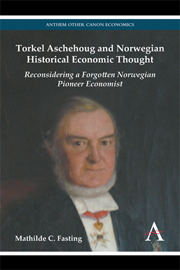 Torkel Aschehoug and Norwegian Historical Economic Thought
Torkel Aschehoug and Norwegian Historical Economic Thought Published online by Cambridge University Press: 05 March 2014
The third and final international influence on Aschehoug to be analysed in this book, that of the French, will be the topic for this chapter. Even though the French influence on his economic thought was not central, it was nevertheless substantial. More than one hundred and thirty different French authors can be found in his author index. A brief re-examination of Aschehoug's own research position, which it is important to understand while reading Socialøkonomik, will be followed by a more thorough analysis of Aschehoug's work in order to outline how he used, and was inluenced by, French economic, social and political thought. This chapter will show that he mostly found it useful for historical, philosophical and ideological purposes, and as a means to explain his own ideas. It is more often commented on in historical outlines rather than in concrete discussions of economic issues and definitions.
His first sources were from as far back as the eighteenth century, and his comments on the physiocrats and on Turgot will begin this analysis, continuing with the nineteenth century, and two different French traditions or schools of thought. The first is the well-known French liberal school, sometimes referred to as the ‘Paris group’. This school is represented by economic thinkers such as Jean-Baptiste Say, Michel Chevalier, the two brothers Paul and Anatole Leroy-Beaulieu, Charles Dunoyer (1786–1862), Frédéric Bastiat, A. E. Cherbuliez, Maurice Block and Pierre Emile Levasseur (1828–1911).
To save this book to your Kindle, first ensure [email protected] is added to your Approved Personal Document E-mail List under your Personal Document Settings on the Manage Your Content and Devices page of your Amazon account. Then enter the ‘name’ part of your Kindle email address below. Find out more about saving to your Kindle.
Note you can select to save to either the @free.kindle.com or @kindle.com variations. ‘@free.kindle.com’ emails are free but can only be saved to your device when it is connected to wi-fi. ‘@kindle.com’ emails can be delivered even when you are not connected to wi-fi, but note that service fees apply.
Find out more about the Kindle Personal Document Service.
To save content items to your account, please confirm that you agree to abide by our usage policies. If this is the first time you use this feature, you will be asked to authorise Cambridge Core to connect with your account. Find out more about saving content to Dropbox.
To save content items to your account, please confirm that you agree to abide by our usage policies. If this is the first time you use this feature, you will be asked to authorise Cambridge Core to connect with your account. Find out more about saving content to Google Drive.